How to hide a gas pipe in the kitchen: methods of disguise and rules for constructing a box
For some people, there is nothing unusual in the fact that a gas pipe is open to view, while others, on the contrary, try in every possible way to hide elements of communication.
In this article, we examined in detail how to hide a gas pipe in the kitchen, so as not to resort to a radical method - relocation. We examined in detail the most popular methods of camouflage, one of which is the construction of a box, and gave interesting ideas that are easy to implement on your own.
In fact, there are quite a few options for solving this problem, but some of them should not be used - they are unsafe. Therefore, in the article we focused on prohibited camouflage methods.
The content of the article:
Prohibited techniques for masking a pipe
The most popular camouflage methods will help not only hide an unattractive element, but also reveal your creative imagination. Even standard plasterboard sheathing can be expanded with decoupage style.
There are a lot of options for how to hide a gas hose or pipe in the kitchen, but not everyone can be used in a particular case. For example, any independent actions of circumcision and moving part of the pipeline (gas) are strictly prohibited. Such work can only be carried out by a qualified gas technician from the service that services this house.
Moreover, unapproved redevelopment of the gas main entails penalties and, most likely, the entire structure will have to be returned to its original location.
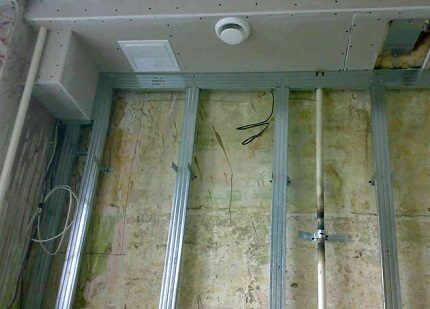
According to SNiP rules for gas supply facilities, the following manipulations with the gas pipeline are prohibited:
- insert the pipe into the ventilation system;
- hide the gas riser with a solid plug in the form of a permanent box;
- hermetic lining;
- drown in the wall.
It is necessary to adhere to all these rules, first of all, for safety reasons. The area around the pipe must be open to avoid gas accumulation if it leaks. Residents of the apartment will not be able to find out about the existing threat in time if this zone is tightly blocked - it will not be able to let in the specific smell in time.
It turns out that the most suitable method of masking a gas pipe in the kitchen is the use of decorative ventilated shields with removable elements. To make sure that the technical design is correct, you will need to contact a gas service technician.
The best ideas for masking pipes
It is possible to make a box for a geyser and pipes from decorative grilles. The dimensions of this design are rather large, so the method is only suitable for kitchens with a large area.
Option #1 - installation of a removable ventilated duct
When making a box yourself, you will need to prepare the following materials: moisture-resistant drywall, metal profiles, screws and scissors for cutting metal.
Stage #1 - choosing a box design
There are a lot of frame options for decorative grilles or drywall; their choice depends on the planned dimensions of the finished structure, as well as on possible additional elements. In some cases, a wooden frame made of slats with a cross section of 50*25 mm or 60*27 mm is used.
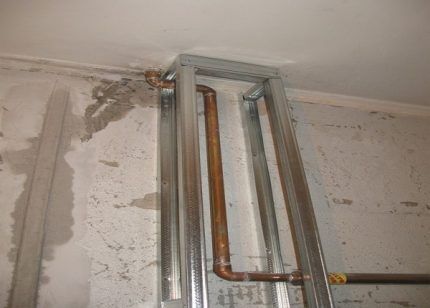
Depending on the location of the pipeline or gas equipment, it is possible to mount a free-standing frame or integrate it into kitchen furniture.
You can also make a false wall to disguise all unaesthetic elements of the gas structure. An artificial wall can occupy the entire kitchen apron. It can be highlighted or, conversely, adjusted to the color of the kitchen set.
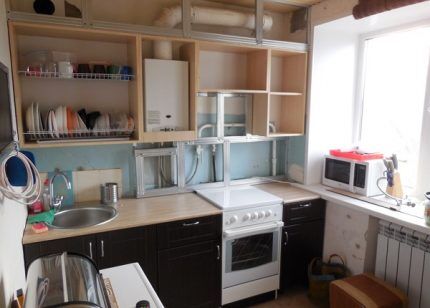
Stage #2 - making a homemade box
The box is a lightweight structure, which is mounted on a metal frame profile and guides. A distinctive characteristic of this method is constant access to gas equipment.
The work of installing the box is divided into several main stages:
- Calculation of the dimensions of the entire structure. The width of the box must be sufficient for unobstructed access during equipment maintenance.
- Installation of the profile frame. The metal profile is secured with self-tapping screws strictly vertically and horizontally, using a bubble level for this.
- Measurements of the finished frame structure.
- Applying markings on plasterboard sheets, according to the measurements taken from the frame.
- Cutting blanks.
- Sheathing with prepared sheets on all sides of the frame.
For the facade of the box, you can choose an interesting decorative element, for example, install a lattice or patterned panel.
Carved screens are also made to order and decorated with original ornaments, both independently and in workshops. It is advisable to paint them to match the color of the kitchen furniture, brush them to create the effect of antiquity in the neo-vintage style, etc.
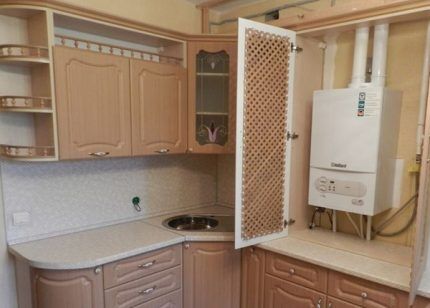
Instead of plasterboard, the frame can be covered with sheets of chipboard, MDF and clapboard. As an option, make a blind device for the box and supplement it with shelves, which can subsequently be used for their intended purpose.
It is also possible to combine the gas system box and kitchen shelves into a single structure.
Stage #3 - homemade decoration
It is especially easy to create decorations on a plasterboard box. This material can easily be covered with a special film for decoupage. By choosing one of the popular styles of this method, and there are many of them, an ordinary box can easily turn into a canvas for creativity.
The application of interesting decorations can be in the simple city style (pasting with newspapers or glossy magazines) or neo-vintage (artificial aging).
In any case, the essence of the method is to clean the pipe or prepare the box, apply glue and place napkins with the selected pattern around the perimeter. Next, a layer of glue is applied again to completely saturate the material.After drying, the decorative element is varnished.
Decorative boxes made of various materials are also often used for masking heating pipes.
Option #2 - arranging a cabinet for pipes
It is possible to hide the gas line without disturbing the overall idea of the interior using kitchen wall cabinets. If you plan to replace kitchen furniture during the renovation process, it is better to immediately consider an additional cabinet to disguise the gas water heater, hose and pipe.
An ordinary wall cabinet, thanks to skillful hands, can turn into a real art object. A horizontally placed pipe will require the installation of a regular cabinet, and a vertical pipe will require a pencil case type cabinet. The main requirement is that the structure must be ventilated.
You can create ventilation by drilling holes or choosing a lattice screen. The geyser located between two cabinets can be hidden by installing an additional front door.
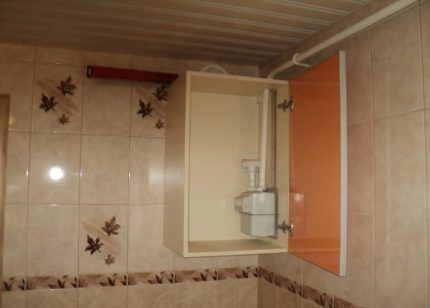
Let's look at how to make your own cabinet from chipboard sheets, 457 mm wide. The first priority is to cut out the constituent elements.
Accessories include:
- roof 19*286*438 – 1 pc.;
- side walls 19*286*762 – 2 pcs.;
- bottom 19*286*438 – 1 piece;
- shelf (if provided for in the project) 19*260*413 – 1 pc.;
- fastening strips 19*38*419 - 2 pcs.;
- stand 19*38*279 – 2 pcs.;
- crossbars for rack 19*57*381 – 2 pcs.;
- door 19*387*413 – 1 pc.
It is also necessary to prepare fittings: pins, nails, hinges and a handle for the door.It is advisable not to deviate from the general composition of the kitchen furniture and not to highlight this area in any particular way. Alternatively, the gas cabinet can be a tone lighter or darker than the rest of the kitchen furniture.
Next, backlashes are drilled inside the side panels for inserting pins. In the upper part of the side walls, select a rebate (10*10 mm) with a chisel and adjust the roof element to the protrusion. Markings are made on the necessary parts where the gas pipe and hoses will pass, taking into account their sizes. Afterwards, holes are cut for them.
The cabinet is assembled using nails and glue. Lastly, install the shelf and hang the door. All that remains is to hang the prepared structure on a gas pipe or column.
Homemade cabinets are not only a practical way to hide a gas pipe. They are used for masking pipes in the toiletby choosing the appropriate design option.
Option #3 - using a railing system
In some houses, the gas line is laid along the kitchen apron area. The pipes run in the empty space between the countertop and the kitchen cabinets. In this case, a railing system will help hide gas communications.
This system is a metal tubular structure that runs along the kitchen apron. It contains fastenings in the form of hooks on which shelves and various kitchen accessories are hung.
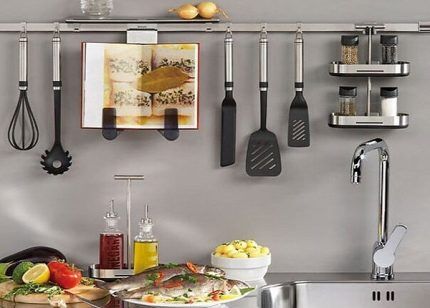
The essence of this method is to use the pipe itself as the main railing element.To do this, you will need to clean the pipe down to the metal base, coat it with a primer, and then paint that imitates chrome. It may be necessary to carry out several stages of painting to achieve the proper chrome plating effect.
After the pipe has dried, you can safely turn your ideas into reality: place a drying rack, shelves with spices, hooks with kitchen utensils, etc.
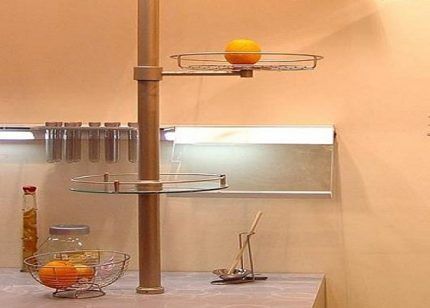
A vertically located pipe can also turn into a railing element. A hole is made in the countertop to fit the diameter of the pipe, it is cleaned, primer is applied and painted.
In addition to chrome, bronze-effect paint is used. Further design depends on the preferences of the kitchen owner - various shelves for fruit, towel holders, etc.
Option #4 - using bright paint
With the help of paint, a gas line can be turned into an object for the embodiment of bold creative ideas. By painting the pipe to match the walls, a harmonious perception of all interior elements can be easily achieved.
Bright color will add richness to the kitchen design. It is advisable to use it only if similar color schemes are present in other parts of the room.
For those who prefer eco style, the option of imitating a birch trunk is suitable, and for representatives of the modern Art Nouveau style, segmented decorative painting will be the best option.

If natural materials, such as stone, were used in the kitchen design, it would be appropriate to use the Provence style. To reproduce it, it will be enough to paint the pipe silver or gold and use the brushing method to obtain a colorfully expressed surface of the natural material.
The painting of gas pipes in ethno style, made with an original ornament, ideally combines with the artificial stone elements of the working area.
You can make one from a gas pipe and use thick twine to help with the trunk of a palm tree. The rope is tightly wrapped around the entire visible perimeter of the highway. Sometimes, artificial citrus fruits are attached to the rope, which brightly complement the created tree. In a similar way they decorate with artificial climbing vines or flowers.
Option #5 - decorating with bamboo panels
The theme of ethno style is light and unobtrusive interior details made from natural materials. Creating a bamboo column to hide a gas pipe is a simple decorative technique.
Any bamboo trunk - natural or artificial - is suitable for use. The basic rule concerns the diameter of the barrel - it should exceed the volume of the pipe by 7-10 mm.
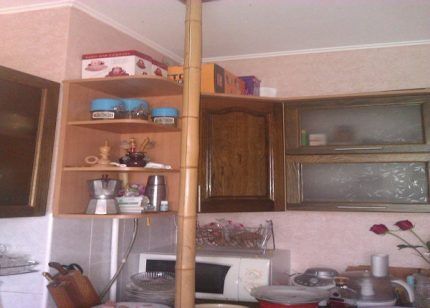
If you purchased a natural tree trunk, you will need to cut it into two even parts and clean the contents from the inside. For the artificial version, the material only needs to be divided in half.
Correct markup is done as follows:
- mark the top and bottom of the trunk using the method of laying a thread;
- wrap the pipe with the same thread so that its ends touch;
- make markings.
Cut the wood along the marked lines. It is also recommended to make several gaps to ensure ventilation.
The further process is not difficult: the pipe is wrapped in stem halves and secured with plastic wire ties. The fastenings are painted over with paint of a suitable color.
Option #6 - using improvised means
If lightweight materials are used for decorative purposes, they can be easily dismantled if necessary. There are many options made from quickly assembled building materials. For example, plywood, cardboard sleeve, plastic, cellular or monolithic polycarbonate.
Polycarbonate is a strong and durable building material. With its help, garage buildings, greenhouses and gazebos are equipped. It is often used at home, for example, for installing a decorative plug for a gas pipe.
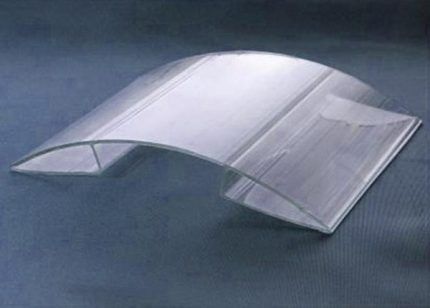
The technology for installing a canopy made of cellular polycarbonate is as follows:
- Having fixed the circumference of the pipe, it is necessary to determine the required height and width of the cladding material blanks.
- The polycarbonate panel is cut with a grinder along the transverse partitions located between the layers of material.
- Several backlashes are drilled at the same pitch on two fold lines.
- The sheet is bent so that the grooves are located at the corners of the box.
- The frame for mounting polycarbonate is made of a metal or wooden profile. It is fixed to the wall with dowels.
- Using self-tapping screws, a polycarbonate cover is installed on the attached profile.
A box made of plywood or plastic panels is installed in the same way. To ensure ventilation, choose perforated plywood sheets. According to the required dimensions, two side panels and one front part are cut from lumber. During cutting, teeth form where the side parts are cut.
The box is assembled by inserting the teeth of the side panels into the openings of the facade. Spacer corners are installed on both sides of the pipe, to which the housing element is glued.
Questions about masking pipes not only in the kitchen, but also in other rooms are quite relevant among ordinary people. Water supply and heating pipes, heating radiators - all of this, as well as a gas pipe, can be decorated or hidden.
We talked about such techniques in our other articles:
- How to hide pipes in the bathroom: a review of the best ways to disguise a pipeline
- How to arrange a box for pipes in a toilet: a review of the best options to disguise the pipeline
- What is the best way to cover a heating radiator: options for masking radiators
Conclusions and useful video on the topic
The video explains how to hide a pipe on a kitchen apron:
Even with a complex arrangement of communications in the kitchen, you can hide gas pipes behind a false wall:
Video on how to quickly and effortlessly build a box for masking pipes:
After familiarizing yourself with the presented methods and features of installing various decorative elements that mask gas communications, you can choose the option that suits your situation.Moreover, the idea can be realized even from scrap materials. The only important aspect remains compliance with safety rules with gas equipment.
Have you skillfully disguised a gas pipe and want to share your experience with other users? Or are you just choosing a suitable camouflage option and want to clarify some nuances? Ask your questions in the comments to our article, add a photo of your pipe, write your recommendations for arrangement.




I made a false panel to hide the gas pipes. Since everything in the kitchen is paneled, this was easy. I nailed slats to the sides of the pipes, attached a plastic profile to them, and inserted my panel into it. If necessary, the profile can be lifted with something flat, and the panel can be easily removed. If you don’t look closely, it is invisible against the background of the wall and does not attract attention.
And I had to slightly redo the wall cabinet from the kitchen unit. I removed the back wall, cut a hole at the bottom and top for the pipe. I made a partition inside. The pipe now runs inside the cabinet.
I covered the space above the cabinets up to the ceiling with chipboard and even made doors there. The outside was covered with self-adhesive wallpaper. The pattern matched exactly like my furniture. It turned out great, just like one big wall. Additional storage space has been created under the ceiling and the pipes are not visible.
You cannot hide the gas valve on the lower side of the box or under the tile, even easily removable ones. According to safety regulations, the tap must be easily accessible at all times. It should be closed when the gas stove (panel or oven) is not used.Do not leave the valve open for more than a day. These are requirements under the Gas Safety Rules. And unwelded connections should not be sewn up...
In short, of course you want to look beautiful, but don’t forget about safety!
Are you crazy? At least what appears in the video is very controversial! The gas pipeline can be hidden in a removable box (or false wall), but they must be ventilated! Not like in the video! He sewed it up, handsome. Before writing such articles, read SNiPs.
Hello, please indicate the specific SNiP that is mandatory for use.